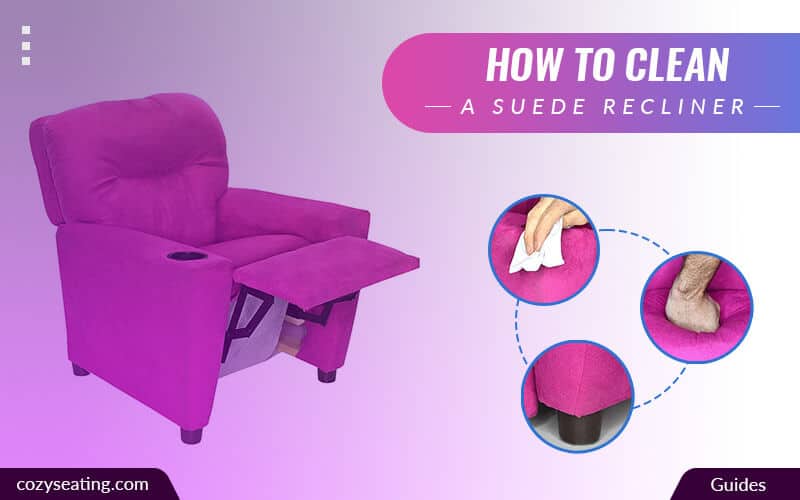
Disclosure: This site is reader-supported & contains affiliate links. We may earn a commission through products purchased using links on this page. Learn more
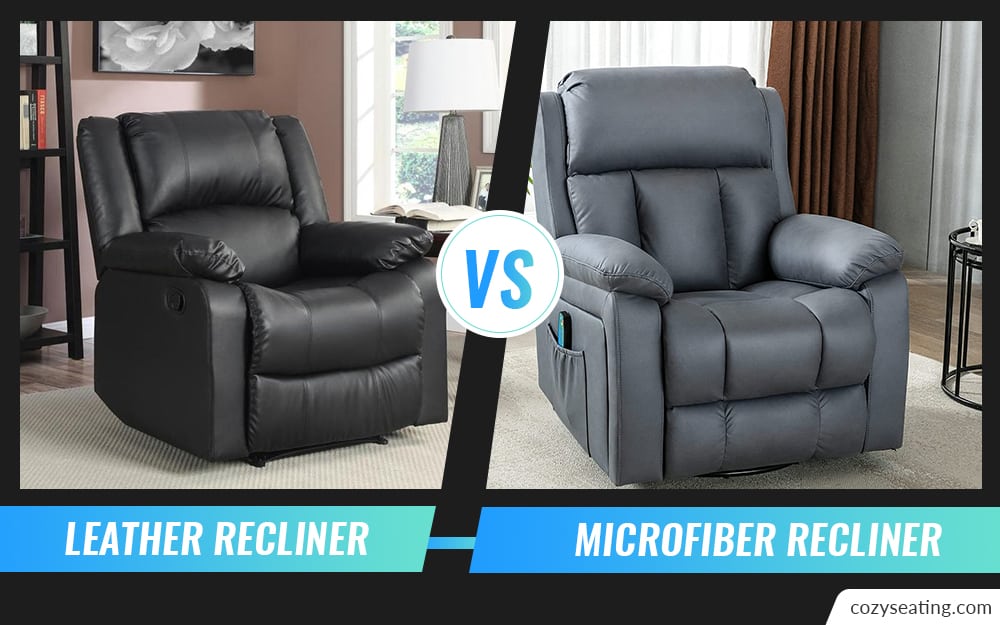
The main difference between a leather and microfiber recliner is the texture of their upholstery. Leather recliners are rough because they’re made from animal hide, which has undergone tanning. On the other hand, microfiber recliners have a fine texture.
So, leather vs. microfiber recliner?
A leather recliner is made of natural skin with clear pores, while a microfiber has artificial skin with a consistent poreless texture. Although both are durable, the former has higher longevity. For that reason, the leather chair is more expensive than its microfiber counterpart.
Only here can you find sufficient information on how leather recliners compare with microfiber recliners. Read till the end for easy decision-making on which of the two pieces of furniture to purchase. Let’s get started.
Table of Contents
Leather Vs. Microfiber Recliner: What’s The Difference?
Leather and microfiber recliners have both similarities and differences. To settle on one, look at your family lifestyle, furniture location, color, the care you can offer, and how much you’re willing to spend. Let’s look at the various factors that make the two chairs different:
1. Comfort
A comfortable upholstery is essential for a recliner to offer maximum comfort. Nonetheless, you have to pick the right furniture to be guaranteed comfort. Leather and microfiber covers provide different levels of satisfaction.
Leather: Has a highly soft and warm feel and adjusts to your body’s temperatures. For instance, top grain leather is cool during summer and warm in winter. Full-grain leather becomes more comfortable with increased use, while the natural leather’s unique fragrance also adds to the comfort.
Microfiber: Natural fibers are the softest fabrics, with linen and cotton leading by a significant margin. The comfort of this upholstery also depends on the frame structure and support system.
2. Appearance
Your furniture’s look is a crucial consideration as it influences the atmosphere of your living room. A living room is a place for you to relax with family and friends, and you want furniture that brightens your mood. It should also align with your decor.
Leather: Top grain leather is naturally beautiful and unique, enhancing the prestigious and intriguing atmosphere of any room. Although its wrinkles may not be all people’s favorite, some may still find the wrinkles as part of the chair’s beauty.
Microfiber: Their fabric comes in various colors, textures, and patterns. That allows you to choose a future that blends well with your living room decor. The upholstery can be woven, printed, solid, or patterned, enabling you to express your unique style.
3. Durability
It’s essential to consider the longevity of your recliner chair because it’s an expensive lifetime investment. The cover of your chair is a crucial contributor to how long it lasts.
Leather: Forms a long-lasting upholstery whose longevity is comparable to none as it can last between 15 to 20 years. Natural oils keep your recliner off peeling, cracking, tearing, and flacking, even along the edges. Leather types like the top grain are too thick and tough to be damaged by pets or small children.
Microfiber: Microfiber is the most durable and synthetic polyester blend among the various fabrics. This fiber is extremely thin and tightly intertwined to build strong layers of protection. That forms a smooth synthetic blend that keeps off dust and other allergens. This fiber also prevents the penetration of spills and dirt, making your recliner more durable.
4. Maintenance
How to clean and maintain your recliner chair is an important deliberation. If you’ve children and pets around, more care is needed. That determines how long the chair will serve you.
Leather: There are different cleaning and maintenance requirements for specific leather covers. Hence, you need to get a recliner whose care you can accord to maintain its beauty and usefulness. This upholstery isn’t heat-friendly and requires periodic vacuuming and dusting.
Microfiber: Various upholstery fabrics are prone to soiling, and microfiber stands out as perfect stain-resistant. The best stain treatment you can give to any recliner cover is immediate attention to the stains using solvents or detergents.
5. Cost
When buying any furniture, its price is essential because you need to work with a budget.
Leather: Leather upholstery is extremely expensive. This fabric has passed the test of time in style and value because of its high quality and durability. For instance, a top-grain, aniline leather recliner can cost more than double any lower grade cover.
Microfiber: Although fibers recliners are relatively cheap, their cost varies depending on several factors. Microfibers have tighter and denser weaves than their counterparts, requiring more labor and raw materials. As a result, their price is high.
Is that all? Not really! Let’s look at each of the two pieces of furniture in detail to identify more distinctive features.
What Are Leather Recliners?

Leather recliners are luxurious chairs made of flexible leather and have a reclining position. Hence, they’re the ultimate pieces of furniture that can provide the maximum relaxation you need after a long day’s work. These recliners can last between seven to fifteen years. Their longevity depends on whether you use them regularly or for decorative purposes.
Like with other recliners, there are manual and power leather recliners. The manual ones are button-controlled, while the power recliners use electricity or rechargeable batteries to function.
There are various leather recliners whose difference comes from the leathers that cover them.
What Are The Types Of Leather Upholstery?
There are various types of leather upholstery that are either natural or synthetic. Genuine leather is soft, flexible, warm, and has a grainy feel. On the other hand, synthetic leather is smooth and plastic-like. The variance depends on the amount of hide present in the particular leather. Below are the diverse types of leather upholstery.
- Genuine leather. Any leather derived from animal hide. This leather varies in quality and durability.
- Artificial leather. It’s an imitation of natural leather made of polyvinyl chloride (PVC). Besides the characteristics of genuine leather, this fabric also offers benefits similar to natural leather.
- Full-grain leather. An extremely high-quality and durable leather that withstands water and moisture. That makes it a costly fabric. Additionally, full-grain leather is prone to stains.
- Top grain leather. It’s made of the outer layer of an animal’s hide. This leather is strong and durable but not like the full-grain one. It comprises densely-packed, fine fibers and comes in different thicknesses giving it a few sub-variations. This leather stretches very easily.
- Corrected grain. A form of full-grain leather subjected to a harsh treatment that corrects all the imperfections.
- Nubuck leather. A sanded full-grain leather with sticky nappy fibers giving it a velvety texture.
- Split leather. It’s the residue leather after the top-grain layer has been removed. It’s lower quality making it less durable than the top-grain leather.
- Patent/ bi-cast leather. A type of split leather coated with polyurethane or vinyl. It looks like real top-grain leather, but it’s stiffer.
- Bonded leather. Recycled or reconstituted and shredded leather bonded together with polyurethane or latex fibers.
- Suede. Soft, nappy leather made of young animals’ skin.
Leather fabric comes in different colors because they’re dyed with various leather dyes.
Types Of Leather Fabric Dyes
There are three major types of dyes that coat leather fabrics after tanning. They include:
- Pigment dye. It’s a polymer surface coating that makes the leather soil and fading resistant.
- Aniline dye. It’s a water-based leather dye that highlights the fabric’s natural variation. It has no pigment or surface coating. Hence, it fades and absorbs water quickly.
- Semi-aniline dye. It contains some oil resulting in a fine finishing that forms a slight coating, while the leather remains naturally looking.
What Are The Features Of Leather Recliners?

There are various features that identify a leather recliner chair. Nonetheless, natural leather differs from synthetic leather. Below are the elements that make up a leather recliner.
- Pores. The pores of natural leather are tiny as they maintain the same size as in the animal of origin. On the other hand, artificial leather has no pores.
- Color. Natural leather maintains a distinct color from the animal hide it’s made of, while synthetic leather comes in different colors.
- Creases and wrinkles. Natural leather has creases and wrinkles, while synthetic one lacks these characteristics.
- Texture. Genuine leather is a bit rough, while artificial leather is smooth because it’s plastic-like.
- Edge. Genuine leather is moderately natural and rough, while synthetic leather is smooth and clean.
- Smell. Natural leather smells like animal hide, while its imitation counterpart has a plastic odor.
What Are The Pros And Cons Of Leather Recliners?

Leather recliners have various disadvantages and disadvantages, including the following:
Pros of leather recliners:
- Durability and care. The longevity of leather recliners is high. However, how long the chair serves you highly depend on the maintenance you provide. Leather is an easy-to-clean upholstery that only requires light dusting or rubbing down. Be sure to familiarize yourself with recommended maintenance procedures for leather to offer the correct care.
- Hypoallergenic. Leather recliners don’t harbor allergens such as dust and pet fur. Therefore, they’re your ideal furniture if you have sensitive skin.
- Appearance. The elegance and uniqueness of leather recliners are unparalleled. These chairs are more trendy, sleeker, and high-end than their fabric equivalent.
- Comfort. Leather recliners are designed to provide the utmost comfort without compromising the style. They’ve got a unique design that allows your feet and back to relax.
Cons of leather recliners:
- Cost. Leather is a high-end material, and therefore, leather recliners are very expensive. This piece of furniture is also costly to maintain. Although investing in a leather recliner is a considerable investment, this chair is worth the cost.
- Prone to damage. Leather recliners can easily be damaged by small children or pets running around. Furthermore, some spills may discolor these chairs if not wiped immediately.
- Heat retention and firmness. These chairs absorb heat quickly during hot seasons and cold in freezing seasons.
What Are Microfiber Recliners?
Microfiber recliners are pieces of furniture fitted with a reclining function and covered with lightweight synthetic material (microfiber). This fabric has gained popularity from its elegance, good feel, and wide range of colors. Nonetheless, microfiber upholstery can be challenging to clean and maintain.
Microfiber’s feel resembles that of suede and can be produced from wool, linen, silk, cotton, acetate, and rayon materials. This upholstery is resilient, light, durable, and affordable.
Like their leather counterparts, microfiber recliners come in various types.
What Are The Types Of Microfiber Upholstery?
There are various types of microfiber upholstery made of either natural or synthetic microfiber. Natural microfibers are made from animals and plants filaments, while synthetic microfibers are produced from chemicals. Additionally, synthetic microfibers are more long-lasting and resistant to stains and fading than their natural counterparts. Contradictorily, these fabrics cost less than the natural ones.
Natural microfibers:
- Cotton. A soft and strong fabric that absorbs moisture quickly. Cotton upholstery is resistant to fading and hence maintaining its great look. Furthermore, these covers are breathable, renewable, and biodegradable. The fabric is prone to shrinking and wrinkling.
- Silk. It’s a smooth texture that has high longevity. Nonetheless, wet silk is 20% less intense. Silk upholstery lacks elasticity and maintains its enlarged state if you stretch it. These covers have exceptionally non-toxic and biodegradable characteristics and become weak when exposed to direct sunlight.
- Wool. It’s the most weighty of all textiles and has high longevity. This fabric has the ability to hold air, hence it can retain heat, keeping it warm. Amazingly, wool’s exterior repels water, while its interior attracts. Its upholstery is a perfect wrinkle, stain, and fading resistant. It doesn’t retain smell because it’s slightly antibacterial.
Synthetic microfiber:
- Polyester. It’s a dull to semi-bright fabric made from petroleum. It’s an excellent blend of natural fibers and creasing resistance. Thus, it maintains the original shape of your chair’s upholstery. This fabric is easy to maintain as it resists water, fading, wrinkling, and abrasion. However, polyester covers have the tendency to pill, and once stained, it’s challenging to correct the mess.
- Acrylic. It’s a fabric that’s knitted or woven with acrylic yarns. This upholstery is wool-like because it’s warm, soft, and lightweight. Additionally, these covers have shape retention and non-allergic characteristics. They’re oil, sunlight, and chemical resistant and can draw water away from your body. Nevertheless, these fabrics are prone to abrasion and pilling.
- Nylon. It’s a synthetic material that is a product of petrochemicals. It’s a solid yet weightless fabric that absorbs low moisture content. It’s resilient, elastic, and resistant to wrinkling, abrasion, mildew, and mold. Moreover, these covers resist most chemicals and oil. Direct sunlight affects nylon upholstery, turning yellow years down the line.
What Are The Features Of Microfiber Recliners?

There are various features of microfiber recliners. Whether natural or synthetic, below are the general properties of the upholstery that make up microfiber recliners.
- It’s an extremely fine linear density that is below 0.1 dtex/f. It’s more refined than the most fragile silk fabric.
- Great drapability. It hangs perfectly well under its weight.
- Very soft as they have a luxurious silken or suede touch.
- Water friendliness. You can wash or dry clean microfiber covers.
- Not prone to shrinking. Dry your recliner covers with air after cleaning them, and you won’t have to care about shrinking.
- High longevity and strength. The fabric can last up to 5 years, and its durability depends on how you use it, what you use it for, and the level of care you offer.
- Make an excellent insulator against rain, wind, and cold.
- Odor and mildew free due to its antibacterial agents making the fabric user-friendly.
- Hypoallergenic, safe for people with allergy problems
- Superb ability to absorb water, absorbing more than seven times its weight
- It takes a short time to dry, about a third of ordinary fibers’ time.
What Are The Pros And Cons Of Microfiber Recliners?
There are several pros and cons that come with microfiber recliners. Let’s look at the two sides of a coin of these covers.
Pros of microfiber recliners:
- Easy to clean. You don’t need to look for a professional to clean your microfiber recliner. The fabric doesn’t absorb water quickly, hence, a towel and some distilled water will do. If the liquid is already dry, apply mild soap and clean the stain.
- Durability. Microfiber is durable. If you have children or pets, you don’t have to worry about your upholstery’s tears or fraying.
- Fading resistance. Microfiber fabrics come in a variety of colors. Your furniture retains its colors even in extreme conditions such as direct sunlight, high temperatures, and regular cleaning.
- Hypoallergenic. Dust is a significant allergen that affects a no of people. If you’re one of them, microfiber recliners are your ideal chairs because they won’t collect dust from the surrounding.
- Less expensive. Microfiber recliners cost less than their leather counterparts. Additionally, you can easily find them in your nearest furniture store or market.
- Luxurious appearance. If you desire to have a leather or suede recliner and your budget can’t allow it, microfiber is your ideal alternative. It gives you the look of leather or suede upholstery you desire at an affordable price.
- Stain resistance. Microfiber covers don’t get stained quickly. If you attend to spills immediately, your recliner won’t be soiled.
Cons of microfiber recliners:
- Mark/ ring development. Microfiber covers tend to retain watermarks. Even though you can easily clean spills with water, a mark is likely left behind. A ring may also result from your failure to attend to water spills, and they dry up on your seat.
- Electrostatic. Microfiber recliners tend to be magnetic to debris such as hair, lint, and pet fur. Such aren’t easily removable and shorten the lifespan of your chair.
- Highly absorbent. Microfiber upholstery has the tendency to absorb water up to 7 times its weight.
- Sensitivity. You shouldn’t keep your microfiber recliner in a high-temperature atmosphere as it’s prone to heating and warping.
- Sugar vulnerability. Microfibers absorb sugary fluids quickly, while their removal isn’t straightforward.
FAQ
What Lasts Longer, Microfiber Or Leather?
Leather lasts longer than microfiber. A good leather piece of furniture lasts more than 25 years, while its microfiber counterpart usually lasts between 7 to 10 years. Faux leather has a life span of between three and five years. Nonetheless, your furniture’s longevity highly depends on the care you accord it. A well-kept microfiber recliner lasts longer than an unkept high-quality leather recline.
Is Microfiber Considered Faux Leather?
Yes, microfiber is considered faux leather. Microfiber leather is a form of microfiber polyurethane synthetic (faux) leather, with the highest quality artificial leather. Furthermore, this fabric has an exceptional performance that ranks it the best genuine leather substitute. Microfiber is in the third generation of synthetic leather.
Does Microfiber Tear Easily?
Microfiber doesn’t tear easily. Why? Because it’s the strongest fabric. Consequently, it serves as a covering material for items prone to wear and tear, like recliners.
Is Microfiber Healthy To Sleep On?
Yes, microfiber is healthy to sleep on. It’s ideal if you’ve got sensitive skin. It’s comfortable enough to enhance a good sleeping atmosphere. For that reason, you can turn your microfiber recliner into a bed and have a sleeping posture and feel change like no other!
Why Is Microfiber Bad For The Environment?
Microfiber is bad for the environment because its fibers are too small to be sieved by waste treatment companies. These tiny fibers swim through water pipes into the rivers and oceans. As a result, it causes water pollution that’s health hazardous to marine life.
Leather Vs. Microfiber Recliner: Which Is Your Ideal Choice?
Buying a recliner is a huge investment that requires adequate prior preparation to make the right choice of furniture. When presented with leather and microfiber recliners, there are various factors to consider to differentiate them and settle on one.
Leather recliners are more durable and have higher quality; thus, the chairs are a bit expensive. On the other hand, microfibers are durable and less pricey. Nonetheless, the longevity of both recliners depends on the care you give them.
After reading through this article, you can now take the right footing toward choosing your ideal recliner and enjoy the utmost comfort you’re looking for!
Recommended Reading

How To Clean Suede Recliner (Pro Guide)
Discover how to clean suede recliner fast and easy. Keep your favorite piece of furniture looking elegant and clean.
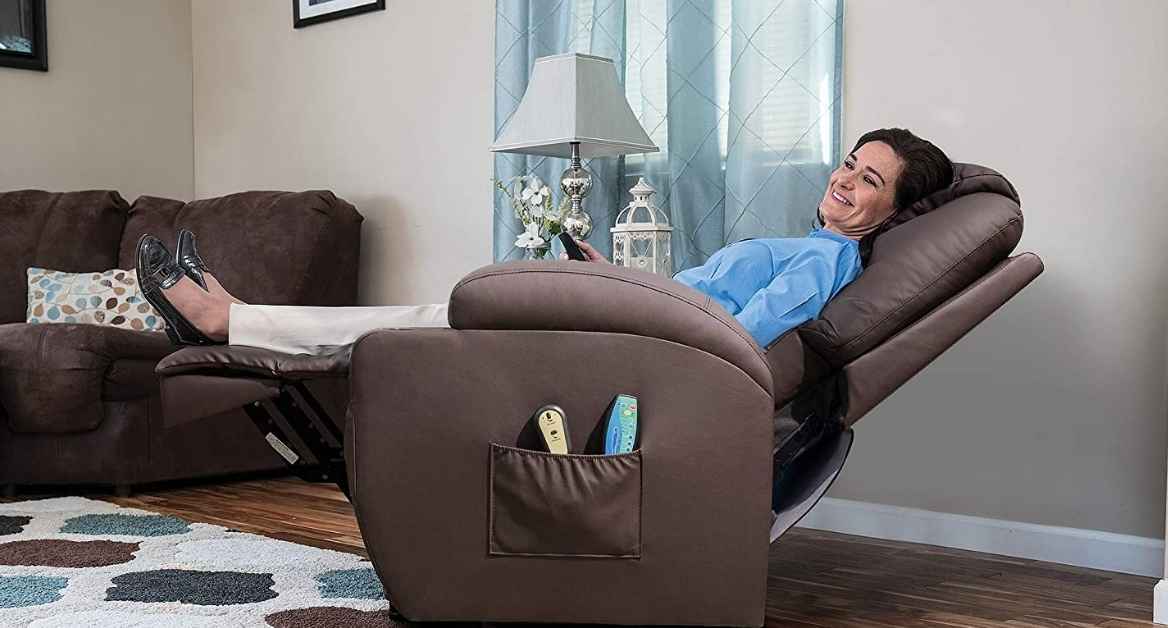
How To Replace A Recliner Spring: An Easy To Follow DIY Guide
Save yourself a chunk of money by learning how to replace a recliner spring with this super simple DIY guide. All you need is the right tools and a little time in your hands.
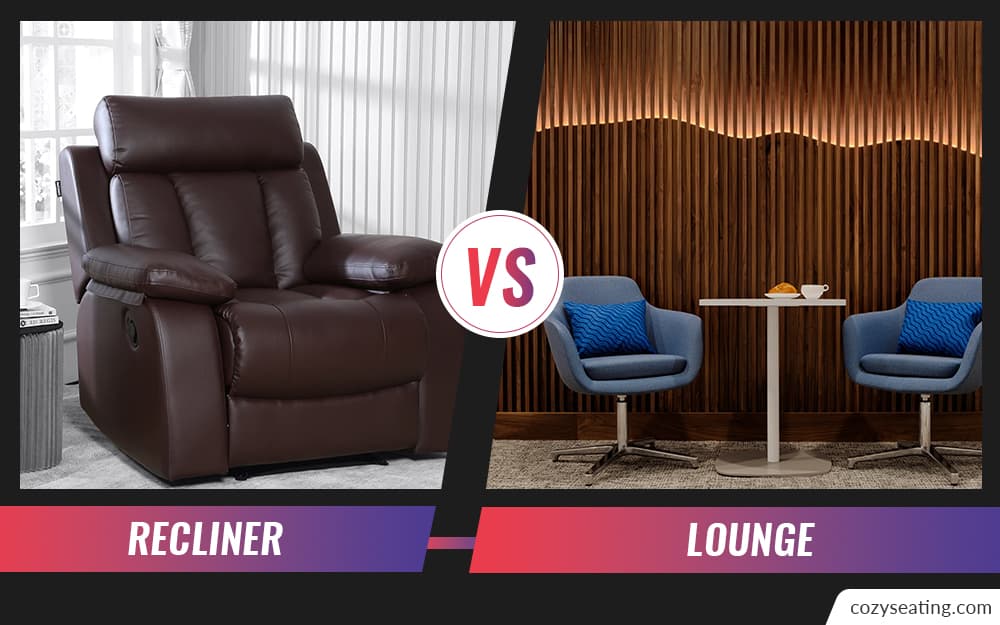
Recliner Vs. Lounge
Recliner vs. lounge? Which of the two comfy chairs is ideal for you? Explore this informative guide and gain sufficient knowledge to make an informed decision.
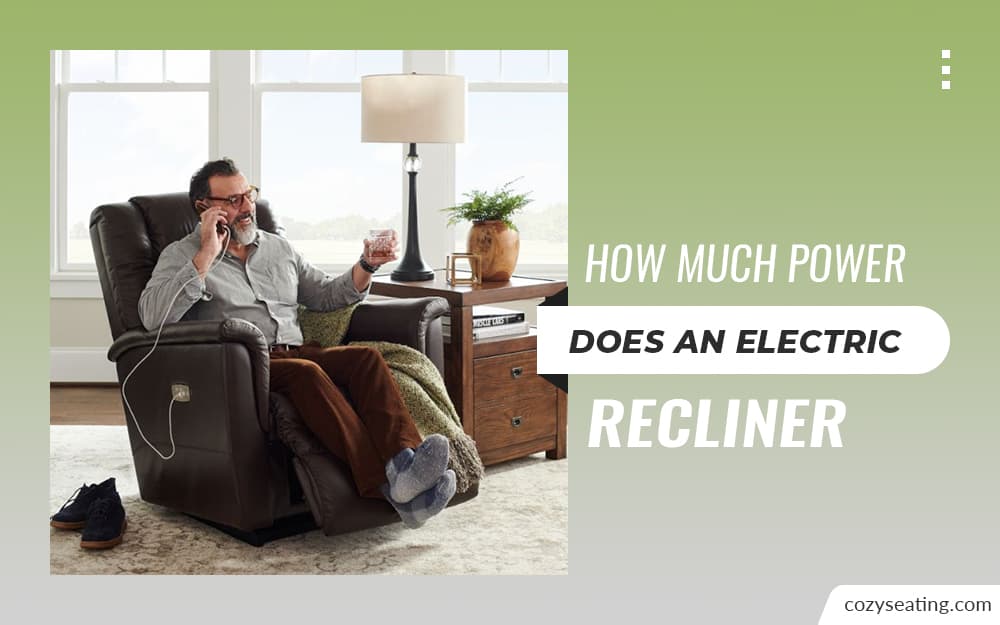
How Much Power Does an Electric Recliner Use?
How much power does an electric recliner use? Depending on the make of your recliner, your recliner could use 14W on standby or 58W in full-motion. Read on.
